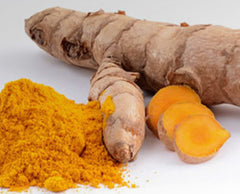Turmeric – the homeopathic world has been touting the benefits of tur meric for years. As with most of these alternative therapies, public interest waxes and wanes. Lately it's waxing. And for good reason. Turmeric is credited with a bounty of health benefits. Let's take a look at this remarkable rhizome.
meric for years. As with most of these alternative therapies, public interest waxes and wanes. Lately it's waxing. And for good reason. Turmeric is credited with a bounty of health benefits. Let's take a look at this remarkable rhizome.
Turmeric is native to several Asian countries. It is a perennial that can grow up to 3 feet tall. The part of the plant that is mostly used are the rhizomes (subterranean globes from which the roots grow).
 meric for years. As with most of these alternative therapies, public interest waxes and wanes. Lately it's waxing. And for good reason. Turmeric is credited with a bounty of health benefits. Let's take a look at this remarkable rhizome.
meric for years. As with most of these alternative therapies, public interest waxes and wanes. Lately it's waxing. And for good reason. Turmeric is credited with a bounty of health benefits. Let's take a look at this remarkable rhizome.Turmeric is native to several Asian countries. It is a perennial that can grow up to 3 feet tall. The part of the plant that is mostly used are the rhizomes (subterranean globes from which the roots grow).
 The leaves are also used in cooking. Turmeric has been used for centuries first as a spice and then for its medicinal qualities. It has also been used as a dye. Although typically used in its dried, powdered form, turmeric also is used freshly grated, like it's cousin, ginger.
The leaves are also used in cooking. Turmeric has been used for centuries first as a spice and then for its medicinal qualities. It has also been used as a dye. Although typically used in its dried, powdered form, turmeric also is used freshly grated, like it's cousin, ginger.
In the next section, I will discuss Turmeric's reported medicinal qualities. I will preface with the disclaimer that none of the applications have any hardcore scientific proof. (As we know the big pharmaceutical companies are not going to fund researching on something from which they cannot make money). With that said, there have been several clinical studies that have produced positive results. We can also listen to the experience and wisdom of centuries of ancient eastern cultures and at least try it for ourselves. Turmeric does not stay in the system for long, so there is little chance of toxicity due to over use.
Reported Health Benefits in Humans
The active ingredient in turmeric is curcumin, a phytochemical that is known for its effectiveness in treating a variety of conditions. Research suggests that this naturally-occurring phytochemical works even better than commercial pharmaceuticals marketed as treatments for liver and kidney ailments, inflammation, arthritis, heart health, skin conditions and certain cancers. It is reportedly an excellent detoxifier and immune booster. Depending on the source, the curcumin in turmeric can vary. Researchers suggest that to be most effective, your turmeric's cucumin content should not be less than 3%. However, if you cannot find a better grade, you can simply use a larger dose without any adverse effects.
How to Feed
Feeding turmeric is not terribly complicated. And, as stated above, it doesn't stay in the system long so there is little concern of feeding too much. However, you would not want to waste it. It only takes a a couple of teaspoons added to each meal to garner its many benefits. Research indicates that turmeric performs best with consumed with freshly ground pepper and a fat such as coconut or olive oil. The addition of black pepper and fat improves absorption This blend can be made into a paste that is gently cooked just so it can combine evenly. The mixture can be stored in a jar for up to two weeks in the refrigerator. Suggested ratio is: equal parts of fat and turmeric. Add one tablespoon freshly ground pepper for every half cup of turmeric.
La Bella Cavalla's Turmeric Blend
La Bella Cavalla has taken a little of this work out of the preparation for you. Our Turmeric Blend includes cold-pressed flax seed, freshly ground organic black pepper and organic human-grade turmeric. The guaranteed curcumin content of the turmeric is never less than the recommended 3%. This blend does not require cooking or refrigeration however it should be kept in a cool, dry area, out of direct light. Sprinkle directly on your horse's food; it may be more palatable if moistened and mixed in. My horses don't mind it at all, in fact, they seem to really like it and lick their dishes clean. #Bonappetit







0 comments: